Terdapat berbagai jenis penyakit mata, dari kanak-kanak sehingga ke peringkat dewasa dan tua. Ada penyakit yang perlu diubati dengan segera supaya mata tidak menjadi bertambah rosak dan akhirnya buta. Ada yang hanya sekadar kurang jelas penglihatan yang mana ia hanya memerlukan penggunaan cermin mata untuk memperbaiki penglihatannya.
Sekiranya ada tanda-tanda penyakit mata atau sakit mata, segeralah berjumpa dengan doktor atau pakar mata untuk rawatan segera di peringkat awal.
Oleh itu, untuk lebih memahami pelbagai jenis penyakit mata di kalangan kita, berikut dipanjangkan maklumat asas tentang keadaan penyakit mata yang biasa……
Eye Diseases – Recognize These Common Eye Conditions
Reviewed by Andrew A. Dahl, MD
Many People Miss the Mark on Eye Diseases and Conditions.
A recent survey of 1,000 American adults shows that nearly half — 47% — worry more about losing their sight than about losing their memory and their ability to walk or hear. But almost 30% indicated that they don’t get their eyes checked. Many Americans are unaware of the warning signs of eye diseases and conditions that could cause damage and blindness if not detected and treated soon enough. Let’s take a look at some of the most common eye diseases and conditions.
Glaucoma
Glaucoma (the sneak thief of sight) refers to certain eye diseases that affect the optic nerve and cause vision loss. It typically produces elevated pressure inside the eye, called intraocular pressure (IOP) and can usually be classified as either open-angle (chronic conditions of long duration) or closed-angle (angle closure), which occur suddenly. The elderly, African-Americans, and people with family histories of the disease are at greatest risk. There are no symptoms in the early stages and by the time the patient notices vision changes, visual loss due to glaucoma can only be halted, not reversed. Glaucoma is usually treated with eye drops, although lasers and surgery can also be used. Most cases can be controlled well with these treatments, thereby preventing further loss of vision. Early diagnosis and treatment is the key to preserving sight in people with glaucoma.
Cataracts
Cataract is a painless condition where the normally clear aspirin-sized lens of the eye starts to become cloudy. The result is much like smearing grease over the lens of a camera which impairs normal vision. Causes of cataracts include cortisone medication, trauma, diabetes, and aging. In fact, cataracts will affect most people if they live long enough. Diagnosis can be made when a doctor examines the eyes with a viewing instrument. Symptoms of early cataracts may be improved with new eyeglasses, brighter lighting, anti-glare sunglasses, or magnifying lenses. If these measures do not help, surgically removing the cloudy lens and replacing it with an artificial lens is the only effective treatment. Removal is only necessary when vision loss interferes with your everyday activities, such as driving, reading, or watching TV. You and your eye- care professional can discuss the surgery and once you understand the benefits and risks, you can make an informed decision about whether cataract surgery is right for you. In most cases, delaying cataract surgery will not cause long-term damage to your eye or make the surgery more difficult.
Age-Related Macular Degeneration (AMD)
Age-related macular degeneration is an eye disease with its onset usually after age 60 that progressively destroys the macula, the central portion of the retina, impairing central vision. It rarely causes blindness because only the center of vision is affected. There are two types of AMD — wet and dry — neither of which causes pain. In wet AMD, abnormal blood vessels behind the retina start to grow under the macula and leak blood and fluid causing loss of central vision which may occur quickly. Treatment includes laser surgery, photodynamic therapy, and injections into the eye. None of these will cure the disease and loss of vision may still progress. In dry AMD, the light-sensitive cells in the macula slowly break down causing central vision to diminish over time. Early stages of dry AMD can be treated with high-dose formulations of antioxidants and zinc which may delay and possibly prevent AMD from progressing to a more advanced stage. Once in the advanced stage, no form of treatment can restore vision loss.
Retinal Detachment
A retinal detachment is a separation of the retina from its attachments to its underlying tissue within the eye. Most retinal detachments are a result of a retinal break, hole, or tear. Once the retina has torn, liquid from the vitreous gel (clear gel that fills most of the inside of the eye) passes through the tear and accumulates behind the retina. The build-up of fluid behind the retina is what separates (detaches) the retina from the back of the eye. Flashing lights and floaters may be the initial symptoms of a retinal detachment or of a retinal tear that precedes the detachment itself. Retinal detachments can occur at any age but occur most commonly in younger adults (age 25 to 50) who are highly nearsighted and in older people following cataract surgery. Surgical repair of a retinal detachment is usually successful in reattaching the retina, although more than one procedure may be necessary. Once the retina is reattached, vision usually improves and then stabilizes.
Bacterial Conjunctivitis (Pink Eye)
Pink eye, or conjunctivitis, is redness and inflammation of the membranes (conjuctiva) covering the whites of the eyes and the membranes on the inner part of the eyelids. The term pink-eye is most commonly used to refer to the infectious (viral or bacterial) type of conjunctivitis, but it may also result from allergic reactions or chemical irritants such as air pollution, smoke, or noxious fumes. The infectious form is very common in children and is highly contagious. Children and adults who develop infectious pink eye should see a doctor to determine whether antibiotic treatment is necessary. Most infectious cases are caused by viruses and will not respond to antibiotics. In these instances, the discharge from the eye is clear and watery and symptoms of a cold may be present. Viral infections last from seven to 10 days. Bacterial pink eye generally results in a large amount of discharge that is green to yellow in color. This discharge can accumulate at night and make opening the eye difficult in the morning. Bacterial pink eye usually lasts three to five days and requires antibiotic eye drops to help the body remove the bacterial infection. Application of warm washcloths to the eye area is also effective in removing discharge. To reduce the chance of spreading infectious pink eye, those affected should avoid touching the eye area and wash their hands frequently, particularly before applying medications to the eye area. Sharing of towels, washcloths, cosmetics, or eye drops can also spread the infection.
Uveitis
Uveitis (pronounced you-vee-EYE-tis) involves all inflammatory processes of the middle layers of the eye, also called the uveal tract or uvea. The uvea is very important because its many veins and arteries transport blood to the parts of the eye that are critical for vision. Symptoms of uveitis may include eye redness and irritation, blurred vision, eye pain, increased sensitivity to light, and floating spots. Potential causes include infection with a virus, fungus, bacteria or parasite, inflammatory disease affecting other parts of the body, or injury to the eye. Because uveitis is serious, treatment needs to begin right away. For uveitis not caused by an infection, your ophthalmologist may prescribe eye drops containing steroids to reduce swelling and drugs to relieve pain. Antibiotics are used in patients with infectious uveitis. Dark glasses will help with light sensitivity.
Eye Allergies
Severe allergic eye symptoms can be very distressing and are a common reason for visits to the allergist or ophthalmologist. Occasionally, severe eye allergies cause serious damage that can threaten eyesight. Eye allergies usually are associated with other allergic conditions, particularly hay fever (allergic rhinitis) and atopic eczema (dermatitis). Medications and cosmetics can also play a significant role in causing eye allergies. Most people with eye allergies treat themselves and do so quite effectively with OTC products such as eye drops as well as antihistamines and decongestants. If these remedies don’t work or if there is eye pain, extreme redness, or heavy discharge, you should seek medical advice.
Sty (Stye)
A sty (sometimes spelled stye) is a tender, painful red bump located at the base of an eyelash or inside the eyelid. A sty results from an acute infection of the oil glands of the eyelid that occurs after these glands have become clogged. A sty also may arise from an infected hair follicle at the base of an eyelash. Symptoms are generally redness, tenderness, and pain in the affected area. The eye may feel irritated or “scratchy.” Later symptoms can include swelling, discomfort during blinking, watering of the eye, and light sensitivity. A common sign of a sty is a small, yellowish spot at the center of the bump that develops as pus expands in the area. People of all ages and both genders can develop a sty. Application of a warm compress or washcloth to the affected area for 10 minutes, four to six times a day, can speed rupture of the sty and aid in the relief of symptoms. A sty should not be pressed or squeezed to facilitate drainage. If a sty persists for several days, a doctor may lance (drain) the infection under local anesthesia.
Keratoconus
We see through the cornea, which is the clear, central part of the front surface of the eye. Normally, the cornea has a round shape, like a Ping-Pong ball. Sometimes, however, the structure of the cornea is just not strong enough to hold this round shape. The normal pressure inside the eye makes the cornea bulge outward like a cone, causing distorted vision. This condition is called keratoconus. Often the cause of keratoconus is unknown. The disease usually does not cause blindness. However, the changes to the cornea will make it impossible for the eye to focus well even with glasses or soft contact lenses. Rigid contact lenses or corneal transplantation may be necessary to provide good vision.
Blepharitis
Blepharitis is an inflammation of the eyelids and occurs in two forms, anterior (outside of the eyelid) and posterior (inner eyelid). Both types of blepharitis can cause a burning or foreign body sensation, excessive tearing, itching, sensitivity to light, red and swollen eyelids, redness of the eye, blurred vision, frothy tears, dry eye, flaking at the base of the lashes, or crusting of the eyelashes upon awakening. Common causes for anterior blepharitis are bacteria (Staphylococcus) and scalp dandruff while posterior forms are caused by problems with the oil glands in the eyelid. Treatment for both forms involves keeping eyelids clean and free of crusts. Warm compresses should be applied to loosen crusts, followed by a light scrubbing with a cotton swab and a mixture of water and baby shampoo. Because blepharitis rarely goes away completely, most patients must maintain an eyelid hygiene routine for life. If the blepharitis is severe, an eye-care professional may also prescribe antibiotics or steroid eyedrops.
Chalazion (Eyelid Cyst)
A chalazion is a tiny lump of the upper or lower eyelid caused by inflammation of a gland of the lid. It may be soft and fluid-filled or firmer. A chalazion is also referred to as a meibomian cyst, tarsal cyst, or conjunctival granuloma. The narrow opening through which a meibomian gland secretes its material can become clogged from narrowing of the opening or hardening of the sebaceous liquid near the opening. If this occurs, the gland will have a backup of the material it secretes and it will swell. Most chalazions are treated with warm compresses to the eyelid to promote healing and circulation of blood to the inflamed area. Doctors may prescribe an antibiotic drop or ointment to be used immediately after the compresses. If the chalazion persists and is causing an unsightly lump, it can be removed surgically through the inside of the lid.
Corneal Ulcer
Most corneal ulcers are caused by infections and can be bacterial (common in people who wear contact lenses), viral herpes simplex virus and varicella virus, or fungal (improper care of contact lenses or overuse of eyedrops that contain steroids). Symptoms include red eyes, pain, feeling like something is in the eye, tearing, pus/thick discharge, blurry vision, pain from bright lights, swollen eyelids, or a white or gray round spot on the cornea. Self-treatment consists of removing contact lenses, applying a cool compress to the affected eye, washing hands often, and OTC pain medications such Tylenol or Motrin. Anyone with a corneal ulcer should be seen immediately by an ophthalmologist, who will do testing and most likely prescribe antibiotic and other eyedrops. If the ulcer persists or worsens, a surgical procedure known as corneal transplantation may be performed.
Diabetic retinopathy
Diabetic retinopathy, a common complication of diabetes, affects the blood vessels in the retina (the thin light-sensitive membrane that covers the back of the eye). It is due to the retina not receiving enough oxygen. If untreated, it may lead to blindness. If diagnosed and treated promptly, blindness is usually preventable. There are two types: nonproliferative and proliferative retinopathy. Nonproliferative retinopathy is the less severe type in which there may be hemorrhages (bleeding) in the retina and leakage of blood or serum causing a “wet retina.” As a consequence vision may be diminished. Proliferative retinopathy is a more severe type of diabetic retinopathy. New abnormal fragile vessels develop on the surface of the retina and may grow toward the center of the eye. These vessels frequently bleed into the vitreous (the clear jelly in the center of the eye). Such bleeding episodes cause severe visual problems. Treatment is by laser surgery or surgery on the vitreous. These techniques can slow the progression of diabetic retinopathy and sometimes will reverse visual loss. However, damage done may be permanent. Diabetic retinopathy can often be prevented by lifestyle modification, including weight loss, dietary changes, and exercise. In addition, better control of high blood sugar decreases the incidence and the progression of diabetic retinopathy.
Strabismus (crossed eyes)
Strabismus, also known as crossed eyes, is a condition in which the eyes don’t look toward an object together. One of the eyes may look in or out or turn up or down. The danger with strabismus is that the brain may come to rely more on one eye than the other and the less-favored eye fails to develop properly, leading to blindness in that eye. The classic treatment for mild-to-moderate strabismus has long been an eyepatch covering the stronger eye, which forces the weaker eye to do enough work to catch up. Severe strabismus may require surgery.
Floaters
“Eye floaters” are deposits or condensation in the vitreous jelly of the eye. People use the term eye floaters to describe seeing floating spots within their vision when they look around. People describe eye floaters as spots, straight and curved lines, strings, or “O” or “C” shaped blobs. Some see a single floater while others may think they see hundreds. Floaters may be present in one or both eyes. The majority of eye floaters are caused by normal aging changes within the eye. However, a person developing symptoms of eye floaters should be checked by an ophthalmologist to make certain that there is no associated eye abnormality which requires treatment. Most floaters will fade over time and become less annoying or noticeable. Herbs, vitamins, and iodine-containing products have been touted as effective in decreasing eye floaters. However, none of these have been proven effective in clinical trials.
Farsightedness (hyperopia)
About one in four people in the U.S. have hyperopia or farsightedness, in which people have difficulty focusing on close objects. The occurrence of hyperopia increases with age; at least half of all people over the age of 65 have some degree of farsightedness. The condition occurs when light entering the eye focuses behind the retina instead of directly on it. An abnormally flat cornea or short eye can cause the light to be focused in this fashion. To correct hyperopia you must change the way the light rays bend when entering your eye. Glasses, contact lenses, or refractive surgery can all be used to correct farsightedness.
Nearsightedness (Myopia)
Nearsightedness affects 20%-30% of the population, but this eye disorder is easily corrected with eyeglasses, contact lenses or surgery. People who have myopia or nearsightedness have difficulty seeing distant objects, but can see objects that are near clearly. In people with myopia, the eyeball is too long or the cornea has too much curvature, so the light entering the eye is not focused correctly. Light rays of images focus in front of the retina, the light-sensitive part of the eye, rather than directly on the retina, causing blurred vision.
Astigmatism
Astigmatism is a common form of visual impairment in which an image is blurred due to an irregularity in the curvature of the front surface of the eye, the cornea. In astigmatism, the curve of the cornea is shaped more like an American football or a rugby ball rather than a normal spherical basketball. Astigmatism occurs in nearly everybody to some degree. Astigmatism can be hereditary and is often present at birth. It can also result from pressure from the eyelids on the cornea. Almost all degrees of astigmatism can be corrected with properly prescribed eyeglasses or contact lenses. For a person with only a slight degree of astigmatism, corrective lenses may not be needed at all, as long as other conditions such as nearsightedness or farsightedness are not present. Another method for correcting astigmatism is by changing the shape of the cornea through refractive laser eye surgery.
Color Blindness
When we see different colors, we are perceiving differences in the light that is reaching our eyes. The way we see different colors is something like the way we hear different sounds as being low or high. The colors of every rainbow always appear in the same order: red, orange, yellow, green, blue, indigo, and violet. The different colors in each part of the rainbow correspond to a different wavelength of light. Color blindness results from an absence or malfunction of certain color-sensitive cells in the retina. The retina is the nerve layer at the back of the eye that converts light into nerve signals that are sent to the brain. A person with color blindness has trouble seeing red, green, blue, or mixtures of these colors. Most color vision problems are inherited (genetic) and are present at birth. Other color vision problems are caused by aging, disease, injury to the eye (acquired color vision problems), optic nerve problems, or side effects of some medicines. Tests are used to measure the ability to recognize different colors with the most common test being the pseudoisochromatic plate test (also known as the Ishihara color test). The type of color vision problem you have can often be determined by which patterns you can and can’t see in the various plates used for the test. Inherited color vision problems cannot be treated or corrected. Some acquired color vision problems can be treated, depending on the cause.
Proactive Eye Health
Good eye health and eye care are crucial to the value of sight. Be proactive in your eye health by taking a role in maintaining and protecting your sight, preventing common eye disorders, and treating problems early. Eye-care professionals, including ophthalmologists (medical doctors specializing in diseases and surgery of the eye) and optometrists recommend that everyone with visual or other eye signs or symptoms have their eyes checked. In people who have no symptoms, it is recommended that people over 40 have their eyes checked every two years and people over 60 have their eyes checked annually.
sumber dari: sitik.wordpress.com
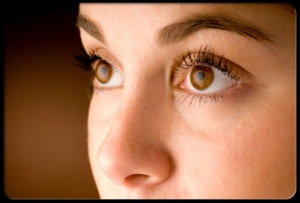
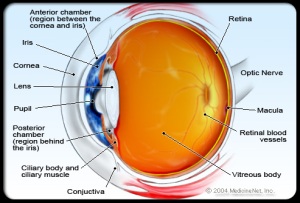





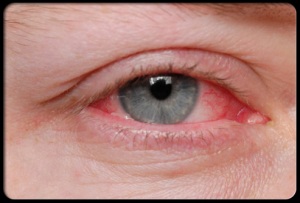




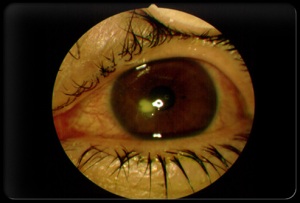
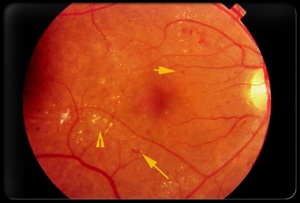






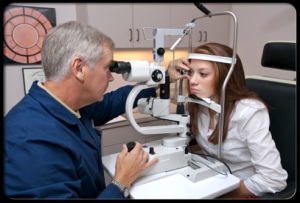
No comments:
Post a Comment